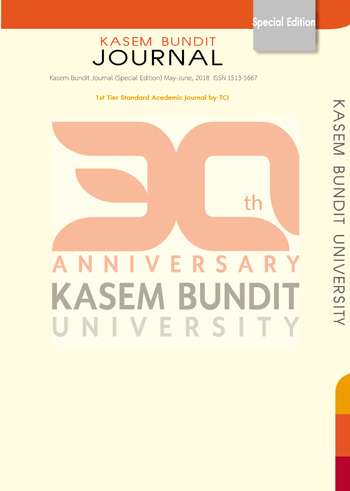The Moderating Effects of Competitive Forces on the Relationship between Human Resource Efficiency and Human Resource Voluntary Disclosure
Keywords:
Human resource efficiency, Voluntary disclosure, Competitive forcesAbstract
The purposes of this research are to investigate the relationship between human resource efficiency and human resource voluntary disclosure and to examine the moderating effects of competitive forces on the relationship. Human resource efficiency consists of human efficiency in profitability, productivity and market value. The sample size is 90 firm-years in technology industry group listed on the Stock Exchange of Thailand. The results of ordinary least squares (OLS) revealed that human resource efficiency in market value was positively related to human resource voluntary disclosure but competitive forces effects were weakened. In addition, competitive force effects on the relationship between human resource efficiency in productivity and voluntary disclosure were weakened. Nevertheless, competitive forces on relationship between human efficiency in profitability and voluntary disclosure were strengthened.
References
[2] Pehrson, A. (2001). The strategic states model: optimum strategies to reach high performance. Management Decision, 39(6), 441-447.
[3] Cappelli,P., &Singh, H.(1992). Integrating strategic human resources and strategic management. Research frontiers in industrial relations and human resources, 165, 192.
[4] Walker, M., (1997). The economics of corporate financial communication. ACCA Occasional Research Paper No 19, Certified Accountants Educational Trust, London, UK.
[5] Grossman, S.J., Hart, O., (1980). Disclosure laws and takeover bids. Journal of Finance,35,323–334.
[6] Rahman, S. (2012). A Review of Firms’ Voluntary Disclosure Decisions With a Focus on Cheap-Talk Models. BRAND. Broad Research in Accounting, Negotiation, and Distribution, 3(1), 64-73.
[7] Fields, T. D., Lys, T. Z., & Vincent, L. (2001). Empirical research on accounting choice. Journal of accounting and economics, 31(1-3), 255-307.
[8] Watts, R. L., & Zimmerman, J. L. (1978). Towards a positive theory of the determination of accounting standards. Accounting review, 112-134.
[9] Ross, S. A. (1977). The determination of financial structure: the incentive-signalling approach. The bell journal of economics, 23-40.
[10] Campbell,D.,P.Shrives, et al. (2001), Voluntary disclosure of mission statements in corporate annual reports: signaling what and to whom?. Business and society review 106(1):65-87.
[11] Boudreau,J.W.(1991), Utility Analysis in Human Resource Management Decisions, Vol.2, Consulting Psychologists Press, Palo Alto,C.A.
[12] Verrecchia, R. E. 1983. Discretionary disclosure. Journal of accounting and economics 5: 179-194.
[13] Wallace. R.S.O., Naser ., & Mora, A.(1994).The relationship between the comprehensiveness of corporate annual reports and firm characteristic in Spain. Accounting and Business Research,25(97), 41-53.
[14] Naser, K,Al-Khatib,K.,& Karbhari,Y.(2002).Empirical evidence on the depth of corporate information disclosure in developing countries: The case of Jordan. International Journal of Commerce and Manangement, 12(3-4),122-155.
[15] Chen, C. J. P. and Jaggi, B. (2000). Association between independent non-executive directors, family Control and financial disclosures in Hong Kong. Journal of Accountant and Public Policy. 19 (4), 285-310.
[16] Clarkson, P. M., Li, Y., Richardson, G. D., & Vasvari, F. P. (2008). Revisiting the relation between environmental performance and environmental disclosure: An empirical analysis. Accounting, organizations and society, 33(4-5), 303-327.
[17] Chadwick, C., & Dabu, A. (2009). Human resources, human resource management, and the competitive advantage of firms: Toward a more comprehensive model of causal linkages. Organization Science, 20(1), 253-272.
[18] Fitz-enz, J. 2009. The ROI of HC: measuring the economic value of employee performance – NY, AMA, 312
[19] Varrecchia , R.E.(1990). Information Quality and Discretionary Disclosure. Journal of Accounting and Economics, 12, 365-380.
[20] Darrough,M. and N.Stoughton (1990). Financial disclosure in an entry game, Journal of Accounting and Economic,12(1-3),219-243.
[21] Ali, A.,S. Klasa, and E. Yeung (2014). Industry concentration and corporate disclosure policy. Journal of Accounting and Economics, 58(2-3), 240-264.
[22] Porter, M. E. Competitive Strategy: Techniques for Analyzing Industries and Competitors. New York: Free Press, 1980.
[23] Rob Gray, Reza Kouhy, Simon Lavers, (1995). Constructing a research database of social and environmental reporting by UK companies, Accounting, Auditing & Accountability Journal, Vol. 8 Issue: 2, pp.78-101
[24] Kent, P., & Zunker, T. (2013). Attaining legitimacy by employee information in annual reports. Accounting, Auditing & Accountability Journal, 26(7), 072-1106.
[25] Nunnally, J. C., Bernstein, I. H., & Berge, J. M. T. (1967). Psychometric theory (Vol. 226). New York: McGraw-Hill.
[26] Gujarati, D.N.,1988. Basic Econometrics. McGraw-Hill, Singapore.
[27] Hair, Joseph F. and others. (2006). Multivariate Data Analysis. 6 th ed. Prentice Hall.
[28] Alsaeed, K. (2006). The association between firm-specific characteristics and disclosure: The case of Saudi Arabia. Managerial Auditing Journal, 21(5), 476-496.
Downloads
Published
How to Cite
Issue
Section
License
ทัศนคติ ความคิดเห็นใด ๆ ที่ปรากฏในวารสารเกษมบัณฑิตฉบับนี้เป็นของผู้เขียน โดยเฉพาะ มหาวิทยาลัยเกษมบัณฑิตและบรรณาธิการ ไม่จำเป็นต้องมีความเห็นพ้องด้วย







